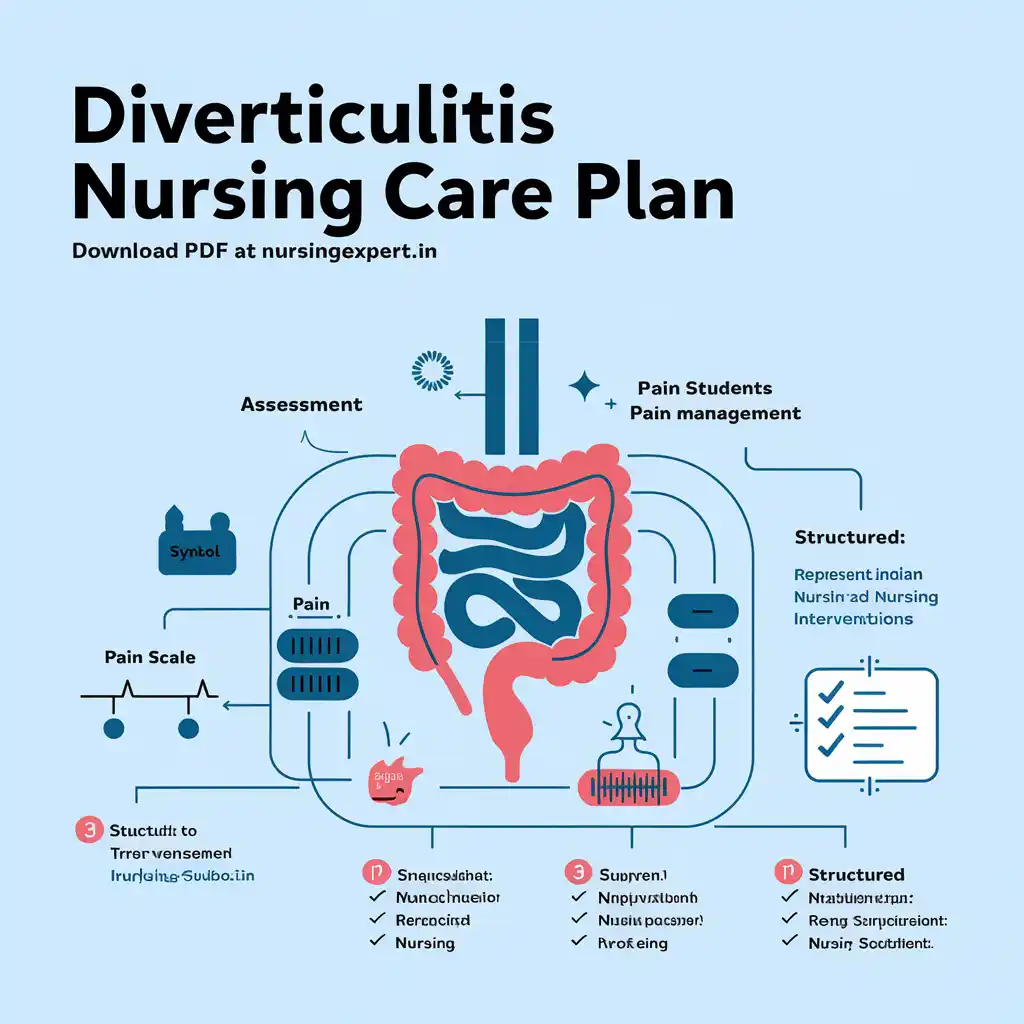Nursing Care Plan for Diverticulitis: Diverticulitis is an inflammation or infection of small pouches called diverticula that can form in the walls of the colon. This condition can cause severe abdominal pain, fever, and changes in bowel habits. For nursing students and professionals, a clear and structured care plan is essential for effective management. This guide presents 5 evidence-based nursing care plans for diverticulitis, detailing assessments, diagnoses, goals, interventions, and patient education. A sample 7-column nursing care plan template is provided below, along with frequently asked questions and a downloadable PDF resource available at NursingExpert.in.
Thank you for reading this post, don't forget to subscribe!
What is Diverticulitis?
Diverticulitis occurs when diverticula (small pouches in the colon) become inflamed or infected. It is a common gastrointestinal condition that can lead to complications such as abscesses or perforation if not managed promptly.


Causes of Diverticulitis
Common causes and risk factors include:
- Aging: Diverticula are more common in older adults.
- Low-Fiber Diet: A diet low in fiber can contribute to constipation and increased pressure in the colon.
- Obesity: Higher body weight is linked with a higher risk.
- Lack of Exercise: Physical inactivity can contribute to bowel problems.
- Genetic Factors: Family history of diverticular disease may increase risk.
Symptoms of Diverticulitis
Patients with diverticulitis may experience:
- Lower abdominal pain, often on the left side
- Fever and chills
- Nausea and vomiting
- Changes in bowel habits (constipation or diarrhea)
- Abdominal tenderness and bloating
Nursing Care Plans & Management
A structured nursing care plan for diverticulitis helps in:
- Managing Pain and Inflammation: Providing relief from abdominal pain and reducing inflammation.
- Preventing Complications: Monitoring for signs of perforation or abscess.
- Optimizing Bowel Function: Supporting dietary modifications and bowel rest.
- Patient Education: Teaching patients about lifestyle changes to prevent recurrence.
- Emotional Support: Helping patients cope with the stress and discomfort of the condition.
Nursing Problem Priorities
- Acute Abdominal Pain and Inflammation
- Risk for Infection and Complications
- Impaired Bowel Function
- Risk for Fluid Volume Imbalance
- Knowledge Deficit Regarding Dietary and Lifestyle Modifications
Nursing Assessment and Diagnostic Findings
- Vital Signs: Monitor temperature, blood pressure, heart rate, and respiratory rate.
- Pain Assessment: Use a standardized pain scale to evaluate abdominal pain.
- Physical Examination: Assess for abdominal tenderness, guarding, or distension.
- Laboratory Tests: Review white blood cell count, CRP levels, and other markers of infection.
- Imaging Studies: CT scan or ultrasound may be used for diagnosis.
- Patient History: Gather information on diet, previous episodes, and lifestyle factors.
Nursing Goals
Short-Term Goals
- Pain Relief: Reduce abdominal pain to ≤3/10 within 2 hours.
- Reduce Inflammation: Decrease signs of inflammation and fever within 24–48 hours.
- Stabilize Vital Signs: Maintain stable vital signs during the acute phase.
- Educate Patient and Family: Ensure understanding of the care plan and necessary lifestyle modifications within 24 hours.
- Prevent Complications: Monitor for signs of abscess or perforation and prevent further infection.
Long-Term Goals
- Optimize Bowel Function: Achieve regular bowel movements and reduce discomfort.
- Sustain Pain Management: Maintain ongoing pain control and minimize recurrent episodes.
- Promote Dietary and Lifestyle Changes: Ensure adherence to a high-fiber diet and regular exercise.
- Enhance Quality of Life: Improve overall well-being and daily functioning.
- Ensure Follow-Up Care: Encourage regular medical follow-ups and adherence to treatment protocols.
Nursing Interventions and Actions
- Managing Pain and Inflammation
- Actions:
- Administer prescribed analgesics and anti-inflammatory medications.
- Apply warm compresses to the affected abdominal area.
- Encourage the patient to rest in a comfortable position.
- Rationale: Reduces pain and inflammation, promoting comfort and recovery.
- Actions:
- Monitoring and Assessment
- Actions:
- Regularly assess vital signs, pain levels, and abdominal tenderness.
- Monitor laboratory values such as WBC count and CRP for signs of infection.
- Document changes in the patient’s condition.
- Rationale: Early detection of complications allows for timely intervention.
- Actions:
- Optimizing Bowel Function
- Actions:
- Encourage a high-fiber diet once the acute phase resolves.
- Educate the patient on the importance of adequate fluid intake.
- Collaborate with a dietitian for personalized nutritional advice.
- Rationale: Promotes regular bowel movements and prevents constipation, reducing colonic pressure.
- Actions:
- Preventing Complications
- Actions:
- Monitor for signs of abscess formation or perforation (e.g., severe pain, rebound tenderness).
- Maintain strict infection control measures.
- Notify the healthcare team immediately if complications arise.
- Rationale: Prevents further infection and reduces the risk of life-threatening complications.
- Actions:
- Patient and Family Education
- Actions:
- Provide clear verbal and written instructions on dietary changes, medication schedules, and exercise routines.
- Use the teach-back method to confirm understanding.
- Offer information on stress management and support groups.
- Rationale: Empowering patients and families promotes adherence to the care plan and prevents recurrence.
- Actions:
Sample Nursing Care Plan for Diverticulitis
| Nursing Diagnosis | Patient Goals/Expected Outcomes | Assessment Data | Nursing Interventions | Rationale | Evaluation | Documentation/Follow-Up |
|---|---|---|---|---|---|---|
| Acute Abdominal Pain | Reduce pain to ≤3/10 within 2 hours | Patient reports pain score of 6/10; tenderness in lower abdomen observed | Administer analgesics and anti-inflammatory medications; apply warm compresses; encourage rest | Relieves pain and reduces inflammation | Pain score decreases; patient appears more comfortable | Record pain assessments and medication response |
| Risk for Infection | Prevent infection; maintain stable vital signs and normal WBC within 24–48 hours | Elevated WBC count; fever present; abdominal tenderness noted | Administer antibiotics as prescribed; monitor temperature and WBC count; maintain aseptic technique | Prevents progression to more serious infections | No signs of infection; vital signs stabilize | Document lab values, temperature, and infection control measures |
| Impaired Bowel Function | Achieve regular bowel movements and reduce abdominal discomfort within 48 hours | History of constipation; irregular bowel habits reported | Encourage high-fiber diet and increased fluid intake; educate on bowel habits; collaborate with dietitian | Promotes bowel regularity and reduces colonic pressure | Improved bowel movements; patient reports less discomfort | Record dietary intake and bowel pattern changes |
| Knowledge Deficit | Patient and family will accurately explain the care plan within 24 hours | Family expresses uncertainty about dietary and lifestyle changes | Provide clear, written instructions and verbal education; use teach-back method to confirm understanding | Enhances adherence to treatment and promotes self-care | Family demonstrates accurate understanding; follows care instructions | Document educational sessions and verify comprehension |
| Anxiety | Reduce patient and family anxiety within 24 hours | Patient and family express stress and worry about condition | Offer emotional support; provide clear explanations about treatment; use relaxation techniques | Reduces emotional distress and builds trust in the care plan | Anxiety decreases; positive feedback received | Document counseling sessions and patient/family feedback |
Downloadable PDF Resource
For your convenience, a detailed Nursing Care Plan for Diverticulitis is available as a downloadable PDF.
Download the Diverticulitis Nursing Care Plan PDF Here at NursingExpert.in
Frequently Asked Questions (FAQs)
- What is diverticulitis?
Diverticulitis is an inflammation or infection of small pouches in the colon, leading to abdominal pain and other digestive symptoms. - What are the common symptoms of diverticulitis?
Symptoms include lower abdominal pain, fever, nausea, and changes in bowel habits. - How is diverticulitis managed?
Management involves pain relief, anti-inflammatory medications, antibiotics if infection is present, and dietary modifications. - What are the key nursing interventions for diverticulitis?
Key interventions include pain management, monitoring vital signs and lab values, promoting proper nutrition, and educating patients on lifestyle modifications. - Where can I download the PDF for this care plan?
You can download the free PDF resource from NursingExpert.in.
Conclusion
Diverticulitis can significantly impact a patient’s digestive health and quality of life. A well-structured nursing care plan focusing on pain management, infection prevention, and patient education is essential for effective management. By following these 5 nursing care plans, Indian nursing students and professionals can provide compassionate, evidence-based care that improves patient outcomes. Use this guide and the downloadable PDF from NursingExpert.in to enhance your clinical practice.
References and Sources
- National Institutes of Health (NIH). (2023). Diverticulitis: Overview and Management. Retrieved from https://www.nih.gov
- Centers for Disease Control and Prevention (CDC). (2023). Diverticular Disease. Retrieved from https://www.cdc.gov
- American Nurses Association (ANA). (2022). Standards for Nursing Practice. Retrieved from https://www.nursingworld.org
- MedlinePlus. (2023). Diverticulitis. Retrieved from https://medlineplus.gov
- World Health Organization (WHO). (2023). Guidelines on Digestive Health. Retrieved from https://www.who.int


